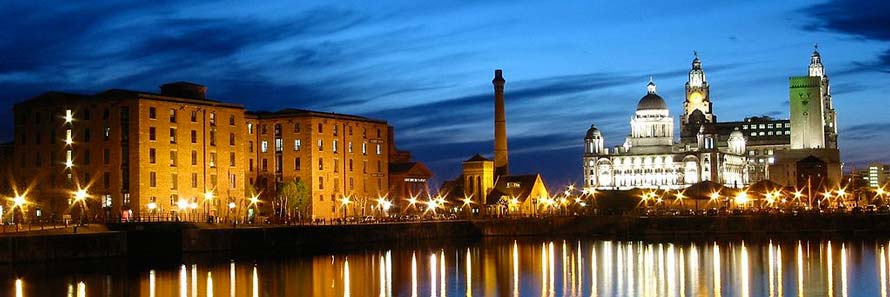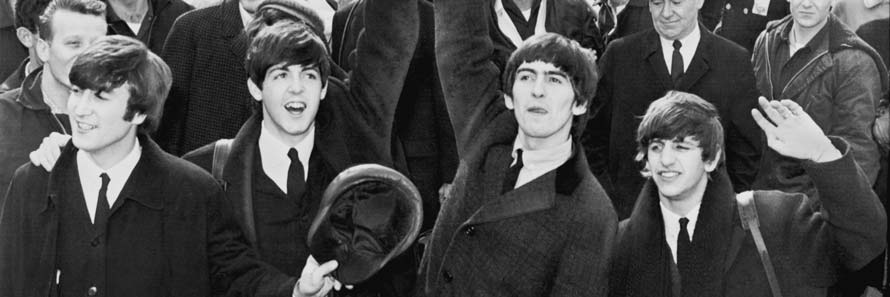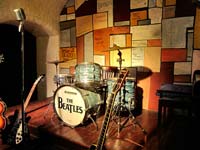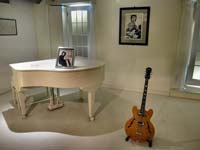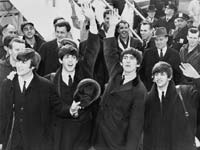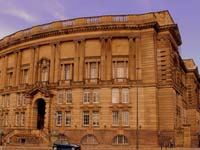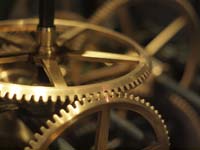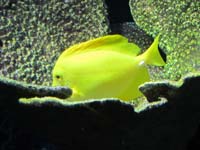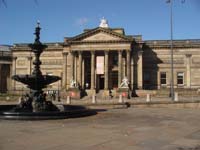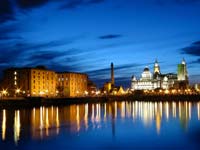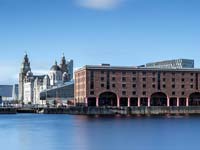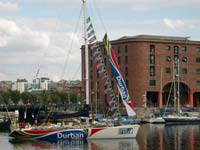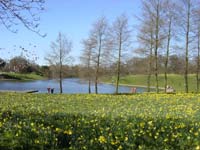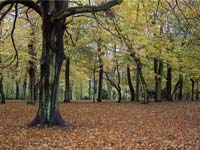Things to do in Liverpool, ENGLAND
Teeming with history and bursting with possibilities for the future, Liverpool is one of England’s most exciting cities.
Though it is impossible to think about Liverpool without thinking of beer, rock, and football, there are many other things to discover. Of course, visiting without rending tribute to the spots that saw the Beatles emerge star-eyed and inexperienced, or without acknowledging the bleeding hearts that beat to the sounds of the national sport would be almost blasphemous. But there is much more that the city can boast about: the world’s largest Anglican cathedral, top-tier museums, and a long and winding history, for example.
As a port town, trade has always been one of its main industries, and has shaped the city in many ways. It has given it its important rank amongst English cities, blotched it with a shameful past of slave trafficking, and drawn people to it from the very beginning.
Today, Liverpool is morphing towards a modern yet edgy version of its former past. The port continues to be the centre of activity, and Victorian architecture can still be enjoyed, but they have now been sprinkled with modernity and 21st century vibes. Its fluvial landscape is dotted with bars, restaurants, and shops that witness the coming and goings of an ever-growing city that promises to keep surprising the world.
To make sure that you make the most of your time, here are 5 of the top things to do in Liverpool.
1. The Beatles Story
The Bath springs have, every day for thousands of years, produced over a million litres of nutrient rich water at a temperature of 46 degrees Celsius.
Dedicated to Sulis Minerva, a Roman goddess believed to have healing powers, the springs drew visitors from all over the empire.
From around 60-70 AD, a 40-metre high bath complex (complete with caldarium, tepidarium and frigidarium) was built alongside a temple dedicated to Sulis.
Sadly, the site fell into disuse and decay after the fifth century Roman withdrawal from Britain and was not reconstructed until the eighteenth century.
Visitors are now able to marvel at the waters from terraces and courtyards built in the eighteenth and nineteenth centuries (richly decorated with statues of Roman Emperor's and military leaders), and to inspect a large number of Roman artifacts in the site's adjoining museum.
The collection's highlights include a gilt bronze head of Silus, the carved Haruspex stone, 12,000 Roman coins thrown into the waters as offerings to the goddess, and remains of the Roman temple (including a stone carving of a Gorgon's head from the temple's pediment).
Visitors are not permitted to bathe in the waters, though this is permitted at the nearby Thermae Bath Spa.
where? The Roman Baths, Abbey Church Yard, Bath BA1 1LZ. The Baths are found in the centre of Bath, which is 160 kms to the west of London and 10 kms to the east of Bristol.
when? Open all year round (except 25 and 26 Dec), from 9 am (or 9.30 am in winter) to between 4.30 pm (in winter) and 9 pm (in high summer).
£$€¥ Adults: £12.50; Concessions: £10.75; Children: £8.
2. The World Museum
The oldest museum in Liverpool is also one of the city’s crowning jewels.
The World Museum opened its doors in 1851 to exhibit the Earl of Derby’s natural history collection. Its wild popularity amongst the residents of Liverpool made it a necessity for the museum to gradually expand to fit more and more subjects. Today, you can enjoy a well of knowledge that includes archaeology, ethnography, astronomy, and, of course, natural sciences.
As the city’s oldest museums, and one that is widely renowned, the World Museum is a source of pride for Liverpool. The museum has recently expanded to accommodate even more exhibitions, and visitors specially love perusing through the aquarium and stargazing at the planetarium.
where? The museum is located on William Brown Street. The stop is quite easy to identify, as it carries its name. It is serviced by buses 25 and 101.
when? In consistency with their commitment to provide the city easy access to culture, the World Museum is open daily from 10:00-17:00.
£$€¥ There is no charge for admission into the museum. However, visitors who wish to buy souvenirs can expect steep prices at the museum shop.
3. The Walker Art Gallery
Liverpool’s most impressive art collection displays works that range from Medieval to modern.
Opened in 1877, the Walker Art Gallery brought to the city of Liverpool a worthy contender to London museums. Referred to as the National Gallery of the north, it boasts an impressive collection that comprises Medieval Art, Pre-Raphaelite paintings, Victorian works, contemporary masterpieces, and more.
It is the proud holder of Hans Holbein the Younger’s Portrait of Henry VIII, one of the most widely recognized portraits of the ruthless king. It also has works by the likes of Peter Paul Rubens, John William Waterhouse, and Edgar Degas.
The wide range of artistic movements represented at the gallery make it a must-see for anyone interested in the fine arts, history, and culture. Though most of the works on display are paintings, there is also a large sculpture gallery, and a section dedicated to the decorative arts.
where? The Walker Art Gallery is located on William Brown Street, only separated from the World Museum by the beautiful Central Library. The closest stop is World Museum, serviced by buses 25 and 101.
when? Except for December 24-26, and New Year’s day and Boxing Day, the museum is open Monday through Sunday from 10:00-17:00.
£$€¥ Like the World Museum, admission to the gallery is free of charge to the general public.
4. Albert Dock
From dining to learning, there are few things you won’t find at Albert Dock.
First built as a dock for cargo ships coming into Liverpool, Albert Dock has become one of Liverpool’s most iconic landmarks. When it was first built, it was the epitome of innovation. Constructed completely from non-combustible materials, it was the first warehouse system of its kind in the entire world.
Its significance to the city and its development cannot be overstated, especially considering that it was one of the major factors in the decision to designate Liverpool as a UNESCO World Heritage Maritime Mercantile City.
Today, Albert Dock continues to be the centre of the universe for locals. It is full of restaurants, shops, galleries, and museums. The later of which include the Beatles Story and the International Slavery Museum.
The dock also offers a wide variety of tours, boat rides, exhibitions, and events. There is so much to do, it can be hard to choose. To know what is going on at a given time, check the dock’s official page.
where? The Albert Dock is a large walkway in Liverpool’s historic waterfront. There are numerous bus lines that service the dock and its attractions. To decide which one to take, search for the specific attraction that you wish to see.
when? It is always a good time to enjoy the dock. During the daytime, shopping, eating, touring, and visiting museums are favourite pastimes. At night, bars and restaurants draw in the most crowds, though the frequent concerts and events easily steal the spotlight on any given day.
£$€¥ You can spend as little or as much at Albert Dock as your heart desires and your wallet allows. Simply walking by the waterfront is a delightful activity, and some of the museums and attractions are free. However, if you want to splurge, there is no shortage of activities that can give you the opportunity to do so.
5. Sefton Park
A much-needed verdant respite from the bustle of city life.
During the Victorian Era, when Liverpool was the second city of England, right after London, development and construction boomed. While this most often applied to museums, housing, roads, and many of the landmarks we can enjoy today, it also included green spaces. Most specifically, it included Sefton Park.
Constructed in 1872, the park expands 235 acres and it is the perfect place in Liverpool to enjoy a bit of nature and fresh air. The park is marked by various fluvial landscapes, including pools, waterfalls, and a man-made lake.
Activities vary and can range from picnicking, to playing sports, to taking a scenic promenade, to napping under a tree. There are also boats to be rented, cafes to pass the time in, and several statues and fountains to be visited. Fishing is allowed in the lake with a permit. Of course, there are also concerts and events that take place throughout the year.
where? Sefton park is located in southern Liverpool in a district that carries its name. Several public transit stops surround the park on all its sides, and there are also entrances and parking lots around it.
when? The park is open 24 hours a day, all days of the year for the enjoyment of the public. However, access can sometimes be limited when a special event is being held here. As common sense dictates, staying in the park after sunset can be risky and is not advisable.
£$€¥ Entrance to the park is completely free to the general public. Of course, specific activities such as events and entrance at cafes will charge for services.
